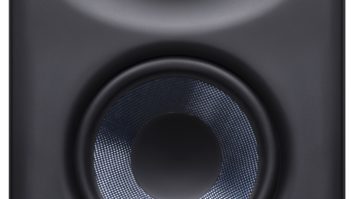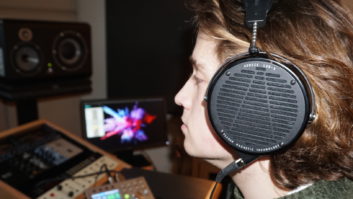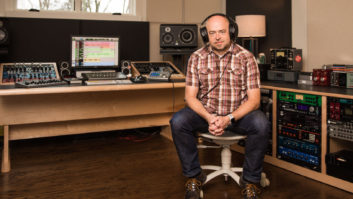While the market seems saturated with economy monitor controllers, the list of truly professional options can be counted on one hand. At the top of the list is Grace Design’s m905, a beautifully designed controller with a wide range of options, making it easily adaptable to practically any monitoring situation.
Arguably more important than any other element in the control room, the monitor controller is the heart of the modern studio. It has significant impact on every creative and critical decision made during the music creation process. To be considered a “professional” monitor controller, the device’s signal path must be both exceedingly accurate and meticulously transparent, and it must provide accurate volume control, including the ability to work at a definitive, properly calibrated listening level, while providing an ample selection of sound source inputs and speaker outputs. The m905 fits this bill.
The Grace m905 replaces the critically acclaimed m904, which has been an industry standard for nearly a decade. While the m905 looks similar to the m904, it has been completely redesigned internally, and both the analog and digital signal paths provide significantly improved performance. The box also boasts an upgraded user interface, including a large customizable TFT display.
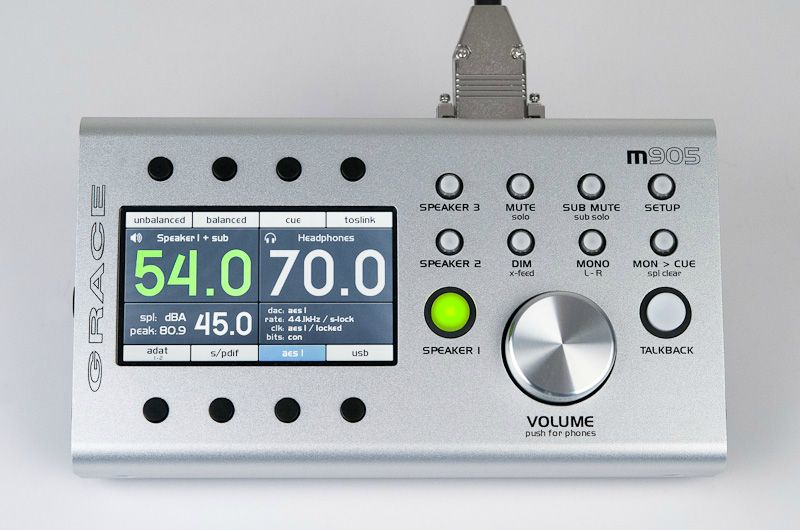
The m905 incorporates a 2U rack unit and a tabletop remote control panel. The substantial rack unit is 9 inches deep and weighs almost 8 pounds. The nearly blank front panel simply incorporates an illuminated power button and a 1/4-inch headphone jack; the comprehensive analog and digital connectivity is found on the rear panel. Analog connections include three pairs of speaker outputs, artist cue out and a multimode stereo subwoofer/DAC/meter output all via pairs of male XLR connectors. Since I don’t have a subwoofer in my mix room, I configured the multimode outputs to operate as program feeds for my Dorrough meters and it worked wonderfully. This type of configuration flexibility is a reminder of the brilliant planning that Grace put into the box’s design.
Related: Review: Grace Design m108 Preamp/Interface, by Rich Tozzoli, Pro Sound News, Oct. 5, 2016
A single male XLR provides talkback output. Balanced (via female XLR) and unbalanced (via RCA) connectors accommodate analog input. Digital input includes two AES3 (via female XLR), S/PDIF (via RCA), TosLink optical, ADAT optical, and USB computer input. The DAC de-emphasis filter can be set to off, on or auto, and is independently configurable for each digital input. Both AES3 (via male XLR) and S/PDIF (via RCA) digital outputs are available, as is toggle switch terminatible word clock I/O. The asynchronous Class-2 USB connection supports stereo PCM audio up to 24-bit/192 kHz and DoP 1.1 DSD audio. When connecting a computer to the m905 via asynchronous mode USB, the m905 becomes the master clock and the computer’s USB bus syncs to the 905’s USB DAC. Syncing the computer to an actual crystal-based audio clock signal significantly lowers the jitter, providing bit-perfect playback.
Grace has covered the bases with the m905’s interfacing options. For example, the AES3 inputs can be configured for dual-wire operation; and both the AES3 and S/PDIF inputs support the DoP 1.1 format, providing for standard and dual-speed DSD connectivity. Check the company’s website if you have unique needs, but I can pretty well guarantee that the unit will have you covered.
The remote control panel measures 8.9 x 6.25 x 2.3 inches and weighs just over 2 pounds. It incorporates a built-in tilt base that allows the unit to be easily configured for the appropriate desktop viewing angle. The large, color LCD screen (4 x 2.25 inches) displays the current volume setting for both outputs in a large, easily readable font with the selected output notated in green. The default display is scaled from 0 to 100 dB and is adjustable in half-decibel increments. Alternatively, a reference level can be set for each speaker and the LED can display the level, in decibels, below or above this reference point.
The panel connects to the rack unit via a 25-foot control cable utilizing 15-pin D-Sub connectors (longer cables can be utilized for custom installations). The panel incorporates a switchable (configurable as latching or momentary) talkback mic, which can be routed to the cue output signal (while simultaneously dimming the speaker outputs and, optionally, the cue source). The same internal mic is used to derive a sound-pressure level of the monitoring environment; that value is displayed on the LCD panel as a handy guide to monitoring level (with customizable A and C weighting filters, peak-hold and ballistics settings).
The device incorporates a built-in mic pre with switchable phantom power and adjustable gain (+15 to +70 dB) to accommodate an external talkback mic. A 1/4-inch TRS jack allows the talkback to be activated footswitch and a tally-light output is offered on the same socket for a remote switch. The rear of the control panel includes a 1/4-inch headphone jack wired in parallel with the headphone jack found on the front of the rack unit. Mini USB connectors on both the rack and the remote control accommodate system firmware updates.
Related: By the Grace of Sound, by Fred Goodman, Pro Sound News, Jan. 23, 2012
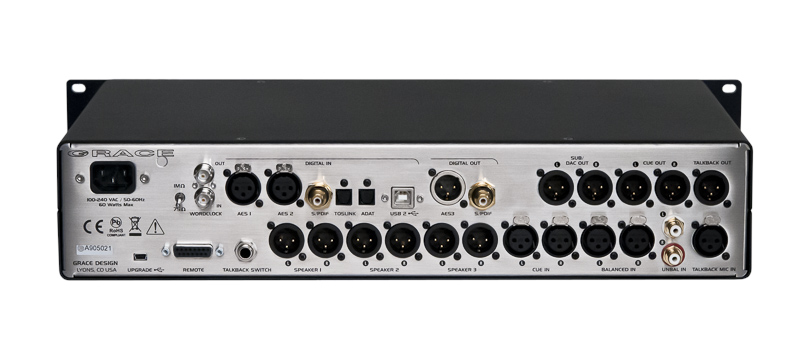
The talkback mic doubles as the SPL meter source, with the SPL level constantly displayed below the speaker volume setting. The digital input source details including sample rate, word depth, clock source and s-Lock status are displayed below the headphone volume setting.
Monitoring functions are controllable via two large and eight small illuminated buttons. A large button selects the primary speaker output, and two small buttons toggle between the secondary speaker pair outputs. The second large button activates the talkback function, and the remaining small buttons access the remaining functionality including speaker and subwoofer mute, Dim, Mono and Setup menu. Five of the small buttons provide secondary functions, which are accessed by holding the button. This includes cross-feed mode, stereo-difference mode, individual speaker solo and peak-SPL clear.
I’m quite impressed with the cross-feed circuit, which is something I haven’t encountered previously. In a normal monitoring situation, the listener/s left ear hears sound primarily from the left speaker and the right ear from the right speaker. The left ear does hear some sound from the right speaker (and vice versa) although at a lower level, with a different frequency response and with a slight delay compared to the right ear. The brain uses this information to create an aural image of the sound field. When listening with headphones, the left ear hears only the left channel and the right ear only hears the right channel, so the brain does not receive the familiar psychoacoustic clues it typically uses to process audio information. This is why it is difficult to create a mix start to finish on headphones. The cross-feed circuit electronically simulates this natural phenomena, allowing accurate mixing to be accomplished with headphones. I’ve spent dozens of hours using the cross-feed function with both Audeze LCD-X headphones and Ultimate Ears UE 18+ Pro IEMs and have had fantastic results in both instances.
My review unit was equipped with the newly optional high-performance RIAA phono preamplifier, which performed wonderfully. My TEAC TN-570 turntable never sounded so good—and with the resurgence of vinyl, having the ability to evaluate that medium critically is more important than ever. Jumpers on the phono module configure cartridge loading, gain and subsonic filter, allowing the preamp to be optimized for a specific cartridge.
Related: Grace Design Two-Channel Felix Instrument and Mic Preamplifier/DI/EQ, by Rich Tozzoli, Pro Sound News, Nov. 10, 2015
Also included on my unit was the Infrared Wireless Remote Option, which allows the m905 to be controlled using wireless infrared via the Grace Design Remote (which was included with my unit), a standard Apple Remote, or with iOS and Android via the Logitech Harmony Remote. Wireless control is the perfect solution if you have a keyboard station or secondary listening position in your control room and need monitor control in that location.
After spending three months with the m905, I’m sold. The beautifully designed box looks spectacular, is ergonomically stunning and provides near-perfect sonic performance. As a longtime user of Grace preamps, the m905 remote has a familiar look and feel and provides an intuitive navigation workflow. Besides making it easy to switch between speaker and headphone playback, the large, detented volume encoder knob has a smooth natural feel that I absolutely love. Being able to customize the source and speaker names simplifies operation, avoids the need of P-touch labeling and makes it easy for new studio clients to adapt to the space.
One might expect a positive reviewer to say the m905 sounds near perfect, but my tests proved that it fails to sound at all, as it provides a sonically transparent monitor path, regardless of source. I’ve never felt closer to the source material than I do with the m905. This is a simply superb device that provides virtually every imaginable monitor controller function, along with uncompromised audio performance.
Grace Design • www.gracedesign.com
